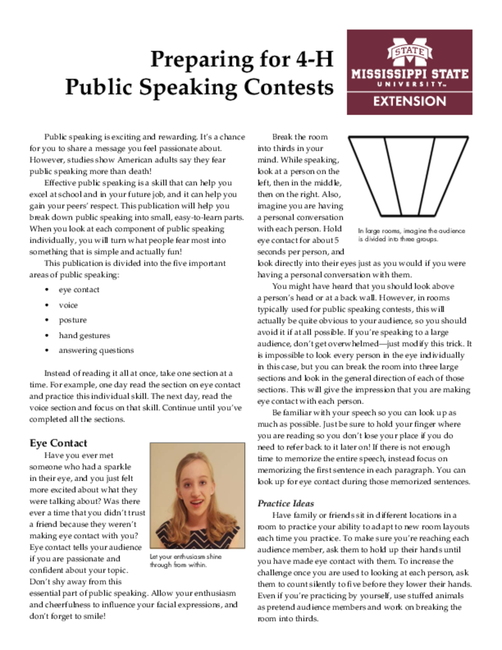Preparing for 4-H Public Speaking Contests
Public speaking is exciting and rewarding. It’s a chance for you to share a message you feel passionate about. However, studies show American adults say they fear public speaking more than death!
Effective public speaking is a skill that can help you excel at school and in your future job, and it can help you gain your peers’ respect. This publication will help you break down public speaking into small, easy-to-learn parts. When you look at each component of public speaking individually, you will turn what people fear most into something that is simple and actually fun!
This publication is divided into the five important areas of public speaking:
- eye contact
- voice
- posture
- hand gestures
- answering questions
Instead of reading it all at once, take one section at a time. For example, one day read the section on eye contact and practice this individual skill. The next day, read the voice section and focus on that skill. Continue until you’ve completed all the sections.
Eye Contact

Have you ever met someone who had a sparkle in their eye, and you just felt more excited about what they were talking about? Was there ever a time that you didn’t trust a friend because they weren’t making eye contact with you? Eye contact tells your audience if you are passionate and confident about your topic. Don’t shy away from this essential part of public speaking. Allow your enthusiasm and cheerfulness to influence your facial expressions, and don’t forget to smile!
Break the room into thirds in your mind. While speaking, look at a person on the left, then in the middle, then on the right. Also, imagine you are having a personal conversation with each person. Hold eye contact for about 5 seconds per person, and look directly into their eyes just as you would if you were having a personal conversation with them.

You might have heard that you should look above a person’s head or at a back wall. However, in rooms typically used for public speaking contests, this will actually be quite obvious to your audience, so you should avoid it if at all possible. If you’re speaking to a large audience, don’t get overwhelmed—just modify this trick. It is impossible to look every person in the eye individually in this case, but you can break the room into three large sections and look in the general direction of each of those sections. This will give the impression that you are making eye contact with each person.
Be familiar with your speech so you can look up as much as possible. Just be sure to hold your finger where you are reading so you don’t lose your place if you do need to refer back to it later on! If there is not enough time to memorize the entire speech, instead focus on memorizing the first sentence in each paragraph. You can look up for eye contact during those memorized sentences.
Practice Ideas
Have family or friends sit in different locations in a room to practice your ability to adapt to new room layouts each time you practice. To make sure you’re reaching each audience member, ask them to hold up their hands until you have made eye contact with them. To increase the challenge once you are used to looking at each person, ask them to count silently to five before they lower their hands. Even if you’re practicing by yourself, use stuffed animals as pretend audience members and work on breaking the room into thirds.

Voice
The quality of your speech doesn’t matter if the audience can’t hear you! Voice can make or break a speaker. It may sound strange, but your voice quality depends mostly on your breathing and posture.
Hold your shoulders and chest high, and plant your feet firmly. Then, speak from your gut—push the air from your stomach so your voice booms. When people are nervous, they tend to speak softly and in a high voice because they are speaking from their chest. Instead, before you begin, take three deep breaths. Never rush into a speech, but use these few seconds to calm your nerves as you envision yourself succeeding. Also, keep a water bottle with you before the speech to allow a few seconds to compose yourself before beginning—just don’t drink while you’re speaking, unless your speech is longer than 45 minutes.
Speed is also an important component of voice. Above everything else discussed in this guide, remember to speak loudly and slowly! If you feel like you are dragging, you are probably going at the right speed. At each paragraph or change of topic, write a note to remind yourself to take a deep breath and pause. This will help keep your nerves under control, and it will allow the audience to process that you are about to change topics. As you become more advanced, think about how you can vary your speed and volume. Speak quickly and loudly for occasional, exciting moments. When you want the audience to lean in for an intimate moment, talk slower and quieter and use more pauses.
Practice Ideas
Practice in a variety of rooms, and always get a friend to listen from the very back corner. Practice in a variety of situations: carpet versus tile, large versus small, full versus empty, and with a lot versus a few people in the audience. These factors affect your volume, and often you won’t know what the setting of your speech will be until you get there. It is best to be prepared for anything!
A good way to learn to speak from your stomach rather than your chest is to practice while a vacuum cleaner is running. If someone sitting 10 feet away can still hear you, you’re probably at the right volume. Write cues to pause in your speech until you get more comfortable.
Posture
Posture is important as soon as you open the door to the room. First impressions occur in the first 15 seconds of meeting a person and often are what an audience remembers most about your speech. Open and close the door confidently, and don’t fidget with the doorknob. Then, as you walk to the spot where you will give your speech, keep looking toward the audience. This does two things: it allows you to survey all aspects of the room (remember learning to adjust to carpet/tile, number/location of people, and so forth), and it shows the audience you are here for them.


Of course, how you stand is also important. Imagine a balloon is tied to your chest. This will remind you to pull your chest upward, hold your shoulders back, and lean forward slightly. Place your feel squarely beneath each shoulder, and avoid rocking back on one hip. Stand on the balls of your feet. Bend your knees slightly to give your posture an energetic look and to avoid locking your legs.
Many speakers want to walk while they speak. However, it is best to avoid this practice until you have mastered the art of public speaking while standing still. Novice speakers tend to pace or fidget nervously during competitions, a habit they may not have shown during practice. Additionally, it demonstrates a great deal of confidence and self-control to remain in one spot. Therefore, try confining your movements to the size of a hula-hoop. Taking one step in one direction to prove a point accomplishes a similar effect to walking across the room. If you do choose to walk during your speech, do so only at three or four key points, and make sure your feet are firmly planted beneath your shoulders before you begin speaking again.
Practice Ideas
Practice your speech in front of a mirror. Also, ask family and friends to remind you to maintain good posture when you are not practicing your speech. Practice confidently opening and closing different doorknobs so you will be able to enter the speaking room gracefully. Also, go to a private place before your competition to practice your “power pose”: Stand quietly with your eyes closed, your shoulders back, and your chest high. Imagine yourself excelling at each component of your speech, from opening the door of the room to answering the final audience question. If you feel really creative, adopt a superhero pose or fist-bump the air to build even more confidence. How we think determines how we will perform—in life and in public speaking.
Hand Gestures

Too many hand gestures or gesturing too boldly while public speaking can distract the audience from your words. Hand gestures can be used to emphasize your main points, or they can be distracting to the audience. Let’s make sure you excel in this area.
Plan your motions. Read through your script and underline the key words of each paragraph. Then, practice in front of a mirror until you know which gesture is most effective for each word. Make sure your gestures are varied, where some gestures are small and close to your chest, others use only one hand, and a few involve both your arms.
Consider when your fingers should be spread apart, held together, or clenched. Counting with your fingers can also be effective once or twice in your speech, but be very clear with your numbering, or your audience will wonder where the missing number is. Always keep your hand gestures high, preferably at your chest so they can be seen over the podium. Imagine the hand gestures you would use when talking with friends; your public speaking gestures should be similar but slightly larger and more animated. Also, remember that touching your hair is not an effective hand gesture, so style your hair so that you can avoid touching it during your speech.
Practice Ideas
Record yourself after you have planned your motions and practiced them in a mirror. Many speakers have a nervous gesture they may not know about until they watch themselves. You can learn to channel any nervous gestures into deliberate motions. Try pausing during everyday conversations to notice what amount and type of gestures you use when talking with your friends. This is the amount you should use when public speaking. If you’re struggling to plan your motions, watch news anchors and game-show hosts to learn new ideas. Also, practice in the clothes and shoes you will wear during the contest. You can’t give a good speech if you’re uncomfortable and can’t move freely. Look as professional as possible, and remember it is better to be overdressed than underdressed.
Answering Questions
Answering questions is your final chance to show what you know! It communicates to the judge how familiar you are with your topic and whether you are able to think on your feet. Share as much as you know about a topic, and remember that the reason you are on stage is because you are the expert attempting to teach the audience.
When a judge asks you a question, take a deep breath and repeat it back to them by saying something like, “If I understand, the question is ____________.” This will make you stand out from the other speakers by showing you are poised. It also gives you a few extra seconds to think of your answer, and if you misunderstood the question, the judge can correct you as you repeat back the question. After you have repeated back the question, look around to the rest of the audience while answering it. Then, return your eye contact to the person who asked the question as you finish. Try to incorporate something you spoke about during your speech to show that you thought through areas where questions might arise. Be sure your voice doesn’t trail off as you finish the question.
Sometimes you won’t know the answer to a question. This is normal! When it happens, don’t panic and never make up an answer. Admitting that there are gaps in your knowledge shows that you are honest, which is a positive attribute. A good tactic is to say something like, “That is a really great question. I don’t know the answer to it right now, but I would love to look into it further when I get home.” You can also try to mention some things that you do know related to the question topic to ensure that the judges remember you are knowledgeable and so that they know you are thinking through the question fully. This can also sometimes refresh your memory so you can think of the actual answer.
Posture is still important during questions. This is one of the most common times for speakers to rock back on one hip or fidget with their hands. Instead, take two or three steps forward from where you finished your speech and plant your feet firmly beneath your shoulders, with your hands at your sides. This makes you seem conversational and will help you refocus for the second part of your contest. Confidence is the most important part of answering questions, and your body language can help communicate your confidence. Take a deep breath and relax. No matter how your speech went, you start with a clean slate for questions, and it’s your time to shine!
Practice Ideas
Follow current events related to your topic. Skim the newspaper and listen to the radio. Try interviewing at least one person who works in the topic of your speech. For example, ask a veterinarian in your town about his/her opinion on a law regarding animal vaccines. Then get as many different people as possible to ask you questions so you can practice answering them. Each person has a different perspective and will ask questions differently. This is excellent practice for the answering-questions portion of public speaking.
Conclusion
Public speaking can be fun, and you can succeed! Each public speaking opportunity is a chance to improve your skills. If you make a mistake, learn from it and move on. Even experienced public speakers have areas they can improve upon—public speaking is a skill that requires many years of practice and is not natural to most people. Have confidence in yourself, and be proud of your courage to speak, no matter the contest results.
Publication 3128 (POD-09-17)
By Brittany Bowman, Extension Undergraduate Apprentice, and Amanda Stone, PhD, Assistant Professor, Animal and Dairy Sciences.
